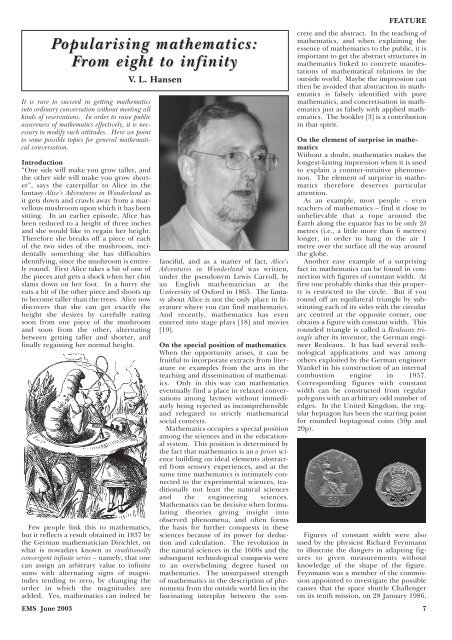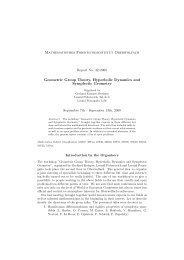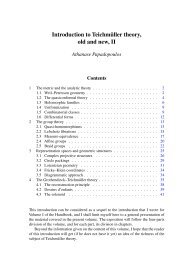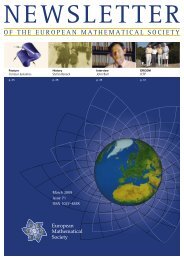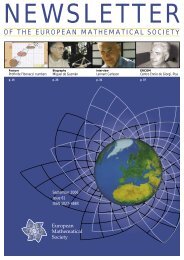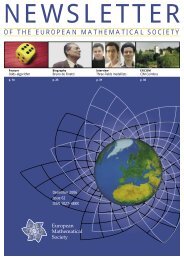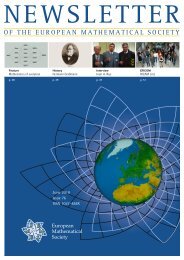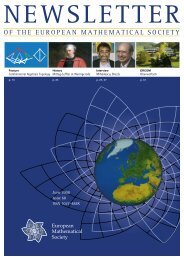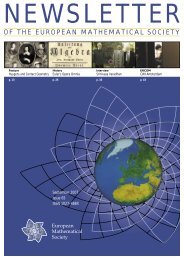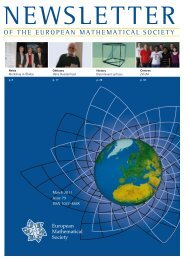June - European Mathematical Society Publishing House
June - European Mathematical Society Publishing House
June - European Mathematical Society Publishing House
You also want an ePaper? Increase the reach of your titles
YUMPU automatically turns print PDFs into web optimized ePapers that Google loves.
Popularising opularising mathematics:<br />
From om eight to infinity<br />
It is rare to succeed in getting mathematics<br />
into ordinary conversation without meeting all<br />
kinds of reservations. In order to raise public<br />
awareness of mathematics effectively, it is necessary<br />
to modify such attitudes. Here we point<br />
to some possible topics for general mathematical<br />
conversation.<br />
Introduction<br />
“One side will make you grow taller, and<br />
the other side will make you grow shorter”,<br />
says the caterpillar to Alice in the<br />
fantasy Alice’s Adventures in Wonderland as<br />
it gets down and crawls away from a marvellous<br />
mushroom upon which it has been<br />
sitting. In an earlier episode, Alice has<br />
been reduced to a height of three inches<br />
and she would like to regain her height.<br />
Therefore she breaks off a piece of each<br />
of the two sides of the mushroom, incidentally<br />
something she has difficulties<br />
identifying, since the mushroom is entirely<br />
round. First Alice takes a bit of one of<br />
the pieces and gets a shock when her chin<br />
slams down on her foot. In a hurry she<br />
eats a bit of the other piece and shoots up<br />
to become taller than the trees. Alice now<br />
discovers that she can get exactly the<br />
height she desires by carefully eating<br />
soon from one piece of the mushroom<br />
and soon from the other, alternating<br />
between getting taller and shorter, and<br />
finally regaining her normal height.<br />
Few people link this to mathematics,<br />
but it reflects a result obtained in 1837 by<br />
the German mathematician Dirichlet, on<br />
what is nowadays known as conditionally<br />
convergent infinite series – namely, that one<br />
can assign an arbitrary value to infinite<br />
sums with alternating signs of magnitudes<br />
tending to zero, by changing the<br />
order in which the magnitudes are<br />
added. Yes, mathematics can indeed be<br />
V. L. Hansen<br />
fanciful, and as a matter of fact, Alice’s<br />
Adventures in Wonderland was written,<br />
under the pseudonym Lewis Carroll, by<br />
an English mathematician at the<br />
University of Oxford in 1865. The fantasy<br />
about Alice is not the only place in literature<br />
where you can find mathematics.<br />
And recently, mathematics has even<br />
entered into stage plays [18] and movies<br />
[19].<br />
On the special position of mathematics<br />
When the opportunity arises, it can be<br />
fruitful to incorporate extracts from literature<br />
or examples from the arts in the<br />
teaching and dissemination of mathematics.<br />
Only in this way can mathematics<br />
eventually find a place in relaxed conversations<br />
among laymen without immediately<br />
being rejected as incomprehensible<br />
and relegated to strictly mathematical<br />
social contexts.<br />
Mathematics occupies a special position<br />
among the sciences and in the educational<br />
system. This position is determined by<br />
the fact that mathematics is an a priori science<br />
building on ideal elements abstracted<br />
from sensory experiences, and at the<br />
same time mathematics is intimately connected<br />
to the experimental sciences, traditionally<br />
not least the natural sciences<br />
and the engineering sciences.<br />
Mathematics can be decisive when formulating<br />
theories giving insight into<br />
observed phenomena, and often forms<br />
the basis for further conquests in these<br />
sciences because of its power for deduction<br />
and calculation. The revolution in<br />
the natural sciences in the 1600s and the<br />
subsequent technological conquests were<br />
to an overwhelming degree based on<br />
mathematics. The unsurpassed strength<br />
of mathematics in the description of phenomena<br />
from the outside world lies in the<br />
fascinating interplay between the con-<br />
FEATURE<br />
crete and the abstract. In the teaching of<br />
mathematics, and when explaining the<br />
essence of mathematics to the public, it is<br />
important to get the abstract structures in<br />
mathematics linked to concrete manifestations<br />
of mathematical relations in the<br />
outside world. Maybe the impression can<br />
then be avoided that abstraction in mathematics<br />
is falsely identified with pure<br />
mathematics, and concretisation in mathematics<br />
just as falsely with applied mathematics.<br />
The booklet [3] is a contribution<br />
in that spirit.<br />
On the element of surprise in mathematics<br />
Without a doubt, mathematics makes the<br />
longest-lasting impression when it is used<br />
to explain a counter-intuitive phenomenon.<br />
The element of surprise in mathematics<br />
therefore deserves particular<br />
attention.<br />
As an example, most people – even<br />
teachers of mathematics – find it close to<br />
unbelievable that a rope around the<br />
Earth along the equator has to be only 2ð<br />
metres (i.e., a little more than 6 metres)<br />
longer, in order to hang in the air 1<br />
metre over the surface all the way around<br />
the globe.<br />
Another easy example of a surprising<br />
fact in mathematics can be found in connection<br />
with figures of constant width. At<br />
first one probably thinks that this property<br />
is restricted to the circle. But if you<br />
round off an equilateral triangle by substituting<br />
each of its sides with the circular<br />
arc centred at the opposite corner, one<br />
obtains a figure with constant width. This<br />
rounded triangle is called a Reuleaux triangle<br />
after its inventor, the German engineer<br />
Reuleaux. It has had several technological<br />
applications and was among<br />
others exploited by the German engineer<br />
Wankel in his construction of an internal<br />
combustion engine in 1957.<br />
Corresponding figures with constant<br />
width can be constructed from regular<br />
polygons with an arbitrary odd number of<br />
edges. In the United Kingdom, the regular<br />
heptagon has been the starting point<br />
for rounded heptagonal coins (50p and<br />
20p).<br />
Figures of constant width were also<br />
used by the physicist Richard Feynmann<br />
to illustrate the dangers in adapting figures<br />
to given measurements without<br />
knowledge of the shape of the figure.<br />
Feynmann was a member of the commission<br />
appointed to investigate the possible<br />
causes that the space shuttle Challenger<br />
on its tenth mission, on 28 January 1986,<br />
EMS <strong>June</strong> 2003 7


